Telefunken FuBK

The Telefunken FuBK broadcasts.
Not as popular as the
Physical equipment
The test card was generated electronically by several
Test card features
Some elements present on the FuBK test card are:[4]
- Cross hatch - makes up the background of the table, with 19x15 white lines over a dark gray (25% luminance) background, allowing adjustment of CRT convergence and focus;
- Circle - provide a way to correct vertical and horizontal raster scan geometrical distortions;
- Colour bars - colour saturationand purity
- Grey staircase - five bars (0%, 25%, 50%, 75%, 100%) that allow setting brightness, linearity and contrast control
- 2T convergence cross - check for signal reflections and group delay, help with geometrical image centring
- horizontal resolution
- Black section- check for reflections, transient response and group delay
- ±V/ +U ramp - two lines that allow checking PAL decoder linearity with UVsignals
- +V/ ±U anti PAL - two achromatic fields to test the PAL decoder delay line
On PAL broadcasts, with a maximum displayable
The two special achromatic fields should be displayed as grey if PAL decoding is functioning correctly. If not, colour will be seen on these areas.[4]
Variations
4:3
- A variation (used by Doordarshan[12] in India, by PTT-NL/Nozema/NOS[13] in the Netherlands, TVR in Romania, YLE[14][15] in Finland, Sky One in the United Kingdom and in West Germany[16][17]) simply omitted the centre circle. This variation is also anecdotally called "Simplified FuBK".
- Another variation adds a second set of colour bars (replacing the ±V/ +U Ramp and +V/ ±U Anti PAL sections) and flips the middle downward triangle. This was used by IRIB in Iran.
- Another variation that adds border castellations and changes the middle downward triangle to a simple vertical bar, used by Kanal 2[18] in Denmark, Rupavahini[19] in Sri Lanka, Televerket Kabel-TV in Sweden and on some German channels.[20][21][22][23][24] Used with further modifications and added graphics by al-Jamahiriya TV (Libya).[25]
- Another modification, again omitting the circle but including a grid cross in the middle and slightly different resolution gratings, was known to be used on some TV transmitters in Belgium and the Netherlands.[26]
- A monochrome variant, omitting the centre circle and replacing the colour bars with a black box showing the transmitter name and channel, as well as an on-screen line gauge replacing the ±V/ +U Ramp and +V/ ±U Anti PAL sections near the bottom, was used on some DBP-operated TV transmitters in West Germany in the 1970s.[27][28][29]
- While not exactly a variant, the Grundig VG 1001 pattern features many of the FuBK test elements, like the colour and grey bars, PAL check area and gratings. This allows it to be used to perform the same adjustments.[9] This pattern was used by a few channels like BRT (Flemish Community of Belgium),[30] SDR (southwest Germany),[31], Polsat (Poland),[32] MVQ-6 (Mackay Region, QLD, Australia),[33] at the headends of many Finnish cable TV providers,[34] as well as on point-to-point cable and satellite feeds in the UK,[35] France, Austria, Italy, Germany, Luxembourg and Belgium.[36] A heavily modified version of the VG 1001 pattern was used for SECAM transmissions by Bulgarian National Television (BNT)[37] during People's Republic of Bulgaria era and also later in PAL by NOVA from its launch in 1994.
16:9
In the 1990s, a FuBK variant in the
Variation Gallery
-
Recreation of the FuBK test card, omitting anti-PAL lines.
-
Recreation of the FuBK square variant omitting the centre circle. ("Simplified FuBK")
-
Recreation of the modified FuBK test card used by IRIB.
-
Recreation of the FuBK test card variation that adds border castellations and changes the middle downward triangle to a simple vertical bar.
-
Recreation of the Telefunken FuBK test card square variation omitting the circle, including a grid cross in the middle, and with slightly different gratings.
-
Recreation of the FuBK monochrome variant, omitting the centre circle and replacing the colour bars with a black box showing the transmitter name and channel, as well as an on-screen line gauge replacing the ±V/ +U Ramp and +V/ ±U Anti PAL sections near the bottom.
-
Recreation of the heavily modified Grundig VG 1001 variant used in Bulgaria.
-
Recreation of the 16:9 / PALplus variation of the FuBK test pattern, same as the one generated from a Grundig VG 1100.
-
Standard 4:3 FuBK pattern showing anti-PAL lines near the bottom right. Generated by a DK-Technologies PT5300.
-
Widescreen FuBK pattern generated by a DK-Technologies PT5300.
-
Widescreen FuBK pattern with anti-PAL and clock cut-outs. Generated by a DK-Technologies PT5300.
Usage
This pattern was used by many broadcasters, including:
- ARD[45] and ZDF[46] (Germany, ARD also used the 16:9 variation)[3]
- Norddeutscher Rundfunk (NDR Fernsehen; Northern German Broadcasting Hamburg)[47][3]
- Westdeutscher Rundfunk (WDR Fernsehen; West German Broadcasting Cologne)[48]
- Südwestrundfunk (SWR Fernsehen; southwest Germany)[49]
- Deutsche Bundespost, Deutsche Telekom and T-Systems (Germany)[50]
- Hessischer Rundfunk (hr-fernsehen, Germany)[51]
- Hrvatska radiotelevizija(Croatian Radiotelevision)
- Argentina Televisora Color, Telefe (Argentina)
- Rupavahini (Sri Lanka)[19]
- RTL9 (Luxembourg)
- Rádio e Televisão de Portugal (RTP; Portuguese public broadcasting corporation)[53][54]
- Islamic Republic of Iran Broadcasting (IRIB; used a variation of the pattern)
- RTL-TVI[55] and VT4[56] (Belgium)
- Canal+ (Belgium; used a modification of the pattern with grid cross)[57]
- NRK (Norwegian Broadcasting Corporation)[3]
- Yugoslav Radio Television (RTV Zagreb, Sarajevo)[63][3][54]
- SRG SSR (SF,[64] TSR,[65] TSI[66]); Teleclub[67] (Switzerland)[68][3][69][70]
- Doordarshan (Indian public television broadcaster; 4:3 version without circle)[12]
- BTV6[71] and GTV9[72] in Australia
- Channel 5 and Channel 7 (Thailand)[73]
- Magyar Televízió (Hungarian public television broadcaster; replaced Philips PM5544 from 2009)[74]
- Alfa TV Budapest, TV2 Hungary[75]
- NPO 1, NPO 2, NPO 3 (Netherlands)[76]
- Nozema and Staatsbedrijf der Posterijen, Telegrafie en Telefonie (Netherlands)[77]
- Televiziunea Română (Romanian public television broadcaster; with[78] and without[79] circle)[80]
- Czechoslovak Television[81]
- ERTT (Tunisia)[82][83]
- M-Net[84] and e.tv[85] (South Africa)
- al-Jamahiriya TV (Libya; original and modified versions)[86][25]
- Kanal 2[18] and TV 2 Zulu[87] (Denmark)
- Channel One Russia[88]
- TVRI from 1974 until 31 December 1984,[89] TPI from 1991 until early-2000 (Indonesia)
- Televerket Kabel-TV (Sweden)[90]
- Sky One (United Kingdom)[91]
- Warszawska Telewizja Kablowa „Porion” (Poland)[92]
Usage Gallery
-
Telefunken FuBK and Philips PM5544 test cards in a Dutch cable TV demonstration in March 1981.
-
Off-air screen capture of ARD Das Erste test card broadcast by WDR from the Sender Nordhelle transmitter in the 1980s.
-
Recreation of the RTL9 testcard (1972–1991), based on a 1982 photo.
Cultural references
The Telefunken FuBK test card is featured in the 2016 Finnish indie video game My Summer Car, which the player's television sets in his house and in the in-game town's jail would show during the in-game overnight broadcast break. This was done to mimic the Finnish public broadcaster YLE's test card, which was used from the 1970s until the 2000s.[93]
See also
References
- ^ Union, European Broadcasting (December 14, 1988). "EBU Review". Administrative Office of the European Broadcasting Union – via Google Books.
- ISBN 9780905228174– via Google Books.
- ^ a b c d e f g "Non-UK Television Test Cards, Tuning Signals, Clocks and Idents". January 12, 2016. Archived from the original on 2016-01-12.
- ^ a b c "Rohde & Schwarz - Signals produced by CCVS + Component Generator SAF and CCVS Generator SFF Standard BG/PAL and N/PAL" (PDF). scdn.rohde-schwarz.com.
- ^ "tv pattern generators gv-798+, gv-898+ | Manualzz". manualzz.com.
- ^ "PT5300 HD-SD VariTime Sync Generator" (PDF). dk-technologies.com.
- ^ Millman, Matthew (2022). "A quick look at some pattern generators (PM5631/PM5644) – Matt's Tech Pages". Retrieved 2023-01-13.
- ^ TV Generators SGPF, SGSF, SGMF (PDF). Germany: ROHDE&SCHWARZ GmbH & Co. KG.
- ^ a b "Videogenerator VG 1001 Equipment Grundig Radio-Vertrieb, RVF". www.radiomuseum.org.
- ^ "Tele Serata". InNice. Retrieved 2023-01-13.
- ^ PT5300 Operating Manual (PDF). Denmark: DK-Technologies A/S. 2009.
- ^ a b "TV-DX Doordarshan DD1 India 09.04.1992" – via www.youtube.com.
- ^ "Testbeeld Markelo 199x" – via www.youtube.com.
- ^ "Television testikuva – Nostalgia-TV" (in Finnish). Retrieved 2023-01-13.
- ^ a b "Reception DX TV Finlande". dxtv (in French). Retrieved 2023-01-14.
- ^ "Reception DX TV Allemagne Rhenanie du Nord Westpha". dxtv.
- ^ "Reception DX TV Allemagne Hesse". dxtv.
- ^ a b "Kanal 2 Danmark" – via www.youtube.com.
- ^ a b "Rupavahini: Closedown And Startup (23.02.2021 - With New Screen Bug)" – via www.youtube.com.
- ^ "Germany West". March 31, 2015 – via Flickr.
- ^ "Germany West". March 30, 2015 – via Flickr.
- ^ "Germany West". March 30, 2015 – via Flickr.
- ^ "Germany West". March 30, 2015 – via Flickr.
- ^ "Testcard Gallery 4". radiovibrations.com. Retrieved 2023-01-13.
- ^ a b "Lybia FuBK Testcard (ca. 1996)" – via www.youtube.com.
- ^ "Testbeelden van de Nederlandse Televisie". www.radio-tv-nederland.nl.
- ^ "Reception DX TV Allemagne Rhenanie du Nord Westpha". dxtv.
- ^ "Reception DX TV Allemagne Rhenanie Palatinat". dxtv.
- ^ "Reception DX TV Allemagne Basse Saxe". dxtv.
- ^ "Reception DX TV Belgique Flamande". dxtv.
- ^ "S3 Pausenfilm und Sendeschluss mit unbekanntem Testbild 20.03.1984" – via www.youtube.com.
- ^ POLSAT - początek emisji programu, 23.15 (576p), retrieved 2023-01-13
- ^ MVQ6 TV Mackay sign-on 1987, retrieved 2023-01-13
- ^ "Kaapeliyhtiöiden testikuvat – Nostalgia-TV" (in Finnish). Retrieved 2023-01-13.
- ^ "BBC1 loss of transmission testcard Calais" – via www.youtube.com.
- ^ "Testcards-feeds". ing-sat.what.hu.
- ^ "БТ-СОФИЯ - BT Sofia Bulgarian TV test card 1988" – via www.youtube.com.
- ^ "Astra ARD PAL Plus". October 8, 2021 – via Flickr.
- ^ "Test Card Telefunken FuBK PALplus" – via www.youtube.com.
- ^ "Grundig video generator VG 1100 - Vintage Photograph". IMS Vintage Photos.
- ^ "Videogenerator VG1100 Equipment Grundig Radio-Vertrieb, RVF". www.radiomuseum.org.
- ^ PT5300 Operating Manual (PDF). Denmark: DK-Technologies A/S. 2009.
- ^ "PolSat - zakończenie programu, flesz pogody i informacje na temat stacji z 8 stycznia 1993r". YouTube.
- ^ "Polsat - Zakończenie pasma popołudniowego (02.05.1993)" – via www.youtube.com.
- ^ "Germany West". March 30, 2015 – via Flickr.
- ^ "Germany West". March 30, 2015 – via Flickr.
- ^ "Germany West". March 30, 2015 – via Flickr.
- ^ "Germany West". March 31, 2015 – via Flickr.
- ^ "Germany West". March 31, 2015 – via Flickr.
- ^ "Germany West". March 30, 2015 – via Flickr.
- ^ "Germany West". March 30, 2015 – via Flickr.
- ^ "Sammlung: Archiv". tsubassa-kurenai.de. Retrieved 2023-01-13.
- ^ "Portugal". March 11, 2015 – via Flickr.
- ^ a b "Wireless World". Wireless World. December 14, 1982 – via Google Books.
- ^ "RTL TVI: fermeture (16 janvier 1990)" – via www.youtube.com.
- ^ "Television Graphics Around the World". www.meldrum.co.uk.
- ^ "Belgium". August 19, 2012 – via Flickr.
- ^ "Finland". August 29, 2012 – via Flickr.
- ^ "MTV Lopettaa, YLE TV1 Jatkaa, Päivän lopetus 11.1.1992" – via www.youtube.com.
- ^ "Kolmoskanava - Päivän lopetus (1987 tai 1988)" – via www.youtube.com.
- ^ "MTV3 Testikuva (Re-Upload) (Kaasukuningas)" – via www.youtube.com.
- ^ "Pastanjauhaja" – via www.youtube.com.
- ^ "Yugoslavia". May 12, 2015 – via Flickr.
- ^ "Programmtafeln zum Sendeschluss TV DRS 11.12.1982" – via www.youtube.com.
- ^ "TSR - fin de programmes + Mire PTT (1996)" – via www.youtube.com.
- ^ "TV-DX / E34-TSI-closedown" – via www.youtube.com.
- ^ "Teleclub Sendeschluss 04.09.1990 [Testbild]" – via www.youtube.com.
- ^ "Switzerland". March 17, 2015 – via Flickr.
- ^ "Television test card – distant memory of the nightly broadcast shutdown". Swiss National Museum - Swiss history blog. July 30, 2021.
- ^ "Eutelsat Teleclub FuBK 1". October 6, 2021 – via Flickr.
- ^ "BTV6 Ballarat TV sign-on 1987" – via www.youtube.com.
- ^ "GTV9 Melbourne FUBK Card" – via www.youtube.com.
- ^ "ช่อง 7 HD กระแสไฟฟ้าขัดข้อง (ปิดสถานีภาคกลางวัน) วันที่ 25 กันยายน พ.ศ. 2533" – via www.youtube.com.
- ^ "Hungarian ETC's". ing-sat.what.hu.
- ^ https://ing-sat.hu/tv-dx-amateurs/podani.htm
- ^ "Netherlands". March 23, 2015 – via Flickr.
- ^ "Ruud's DVB-T DX logboek". www.radio-tv-nederland.nl. Retrieved 2023-01-13.
- ^ "TV-DX / R2-TVR-Bukarest-opening" – via www.youtube.com.
- ^ "Deschiderea programului tvr 2 (21 octombrie 2000)" – via www.youtube.com.
- ^ "Romania". March 13, 2015 – via Flickr.
- ^ "Czechoslovakia". August 11, 2012 – via Flickr.
- ^ "Tunisia". March 5, 2015 – via Flickr.
- ^ "Various Testcards from 16°East (1994) RTM,RTT7,Algeria,Duna" – via www.youtube.com.
- ^ "TV-DX M-NET South Africa S10 13.01.1991" – via www.youtube.com.
- ^ "e.tv test card" – via youtube.com.
- ^ "TV-DX Peoples Revolution TV Libya, opening and news 25.10.1993" – via youtube.com.
- ^ "Denmark". ing-sat.hu. Retrieved 2023-01-13.
- ^ "Channel One RF Telefunken FuBK usage" – via www.youtube.com.
- ^ Indonesia Raya Opening 80-an, retrieved 2024-02-11
- ^ "Testbilder: Yle Stockholm, TV1 och Televerket KabelTV (1987-07-24)". YouTube.
- ^ "BSKYB Test card with Videocrypt encryption tests 1991 (no sound)" – via www.youtube.com.
- ^ "Porion - Fragment planszy testowej z ok. 1997 roku" – via www.youtube.com.
- ^ "my summer car night tv music" – via www.youtube.com.



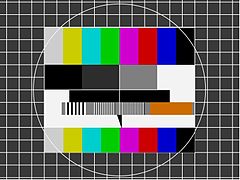
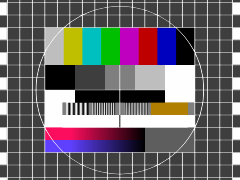
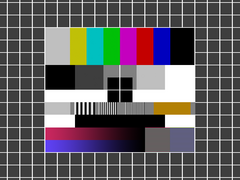



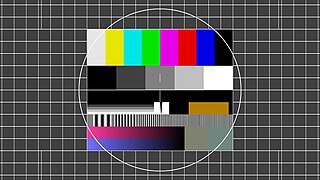

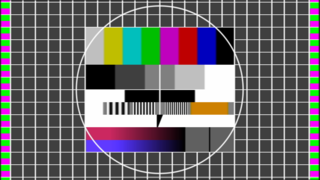


![Off-air screen capture of ARD Das Erste test card broadcast by WDR from the Sender Nordhelle [de] transmitter in the 1980s.](http://upload.wikimedia.org/wikipedia/commons/thumb/f/f6/Sender_Nordhelle_Kanal_30.jpg/239px-Sender_Nordhelle_Kanal_30.jpg)
